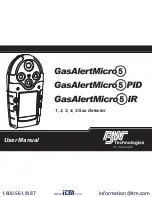
192 • Appendix F: ESS-03 Toxic Sensors
GX-6000 Operator’s Manual
Calibrating the ESS-03 Sensor Using Single Calibration
See “Performing a Span Adjustment” on page 74 for instructions to calibrate the ESS-03
using single calibration.
NOTE:
RKI Instruments, Inc. recommends that you dedicate a regulator for use with
chlorine (Cl
2
) gas and that you do not use that dedicated regulator for any other
gases, particularly hydrogen sulfide (H
2
S).
ESS-03 Bump Testing
See “Performing a Bump Test” on page 87 for instructions to perform a bump test.
NOTE:
RKI Instruments, Inc. recommends that you dedicate a regulator for use with
chlorine (Cl
2
) gas and that you do not use that dedicated regulator for any other
gases, particularly hydrogen sulfide (H
2
S).
Replacing the ESS-03 Sensor or
Changing Sensor Type
When replacing a sensor, you may either replace it with another of the same sensor or you
may install a different ESS-03 sensor. If a different one is installed, the GX-6000 will load
the sensor parameters and configure the ESS-03 channel for the new sensor.
1 . Follow the instructions listed in “Replacing a Sensor” on page 113 keeping the
following exception in mind:
•
A bias board is attached to the bottom of replacement ESS-03 sensors and must
be removed before installing the sensor in the GX-6000. Properly dispose of the
bias board once the sensor has been installed.
Be sure that the new sensor is installed in the same position as the old sensor and that the
following sensor priority for the smart sensor 1 position is maintained.
Table 22: Priority for Smart Sensor 1 Position
For example, if your instrument is a 4-gas + ESS-03 Cl
2
+ ESS-03 NH
3
, the Cl
2
sensor
should be in the smart sensor 1 position and the NH
3
sensor should be in the smart sensor
2 position. If your instrument is a 4-gas + ESS-03 NH
3
, the NH
3
sensor should be in the
High Priority
Low Priority
10.6 eV low range PID
10.0 eV/benzene PID
11.7 eV PID
10.6 eV high range PID
ESS-03 Chlorine
ESS-03 Ammonia
IR and other ESS-03 sensors
















































